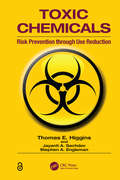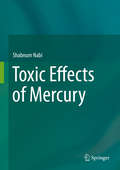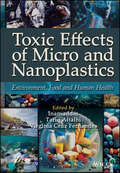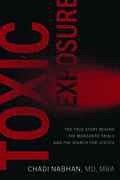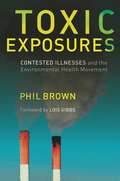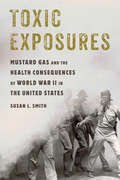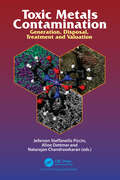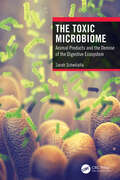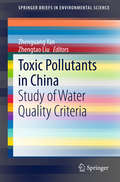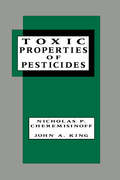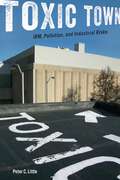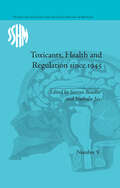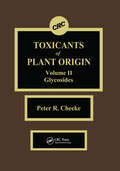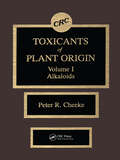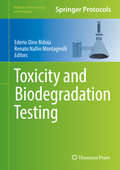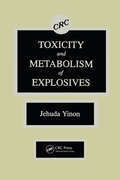- Table View
- List View
Toxic Chemicals: Risk Prevention Through Use Reduction
by Thomas E. Higgins Jayanti A. Sachdev Stephen A. EnglemanCatastrophic events such as the Bhopal, India tragedy and rising incidences of cancer in areas neighboring industrial facilities have heightened concern over the use of toxic chemicals in manufacturing and industry. Based on the authors' research conducted in Sao Paulo, Brazil, this book explores the history of toxic chemical release reporting programs, presents data on the toxicity of chemicals currently in use, discusses variables that contribute to the relative toxicity of a substance, compares existing programs for reducing environmental threats, and provides specific recommendations for reducing or eliminating the use of toxic chemicals.
Toxic Effects of Mercury
by Shabnum NabiMercury is widespread in our environment. Methylmercury, an organic form of mercury, can accumulate in the aquatic food chain and lead to high concentrations in predatory fish. When consumed by humans, contaminated fish represent a public health risk. Toxic Effects of Mercury intends to facilitate among its readers the understanding of the importance of mercury pollution in the environment and the health consequences associated with exposure to this metal. The knowledge on methylmercury (MeHg) toxicity collected over the years is undoubtedly robust creating an impression all that is to be learnt about this metal has already been accomplished. However, in large measure, past knowledge has merely laid the ground for interesting questions that have yet to be fully addressed and concepts have yet to be deciphered. One of my major goals was to make a valiant attempt to include state-of-the-art information on the mechanisms of mercury toxicity, describing its effects on cultured cellular systems as well as in whole living organisms, starting from the lessons learned from the tragic events in Minamata Bay, Japan. A special focus of the book is on the neurotoxic effects of MeHg. An understanding at the cellular level is necessary to gather information on the structural and functional alterations induced by MeHg and how they possibly become unmasked and evident at the behavioral level, 32 chapters of the book have been organised having these considerations in mind. This book will provide state-of-the-art information to the graduate students training in toxicology, risk assessors, researchers and medical providers at large. It is aimed to bring the readers updated information on contemporary issues associated with exposure to methylmercury, from its effects on stem cells and neurons to population studies. It is a valuable resource for individuals interested in the public health effects and regulation of mercury. The report provides an excellent example of the implications of decisions in the risk assessment process for a larger audience and is written with the hope that the information will provide better understanding of the mercury problems which confront us.
Toxic Effects of Micro- and Nanoplastics: Environment, Food and Human Health
by Inamuddin Tariq Altalhi Virgínia Cruz FernandesThis book provides in-depth coverage of the sources, dispersion, life cycle assessment strategies, physico-chemical interactions, methods of analysis, toxicological investigation, and remediation strategies of micro and nanoplastics. Micro and nanoplastics are the degradation products of large plastic compounds. These degraded polymers enter into the natural environment, including air, water, and food, which leads to various significant threats to human health. The nature of these micro and nanoplastics is persistent and consequently accumulates in the exposed person’s body. Research into microplastics has shown that these particles accumulate in various human organs and impart detrimental effects on humans. To safeguard human health, analysis and remediation strategies are necessary. This book provides a comprehensive overview in 24 chapters on the source, distribution, life cycle assessment strategies, physico-chemical interactions, methods of analysis, toxicological investigation, and remediation strategies of micro and nanoplastics. Audience This book is a valuable resource for chemists and polymer scientists in various industries including plastics, fisheries, food and beverages, environmental sciences, agriculture, and medicine, as well as government policymakers.
Toxic Exposure: The True Story behind the Monsanto Trials and the Search for Justice
by Chadi NabhanA behind-the-scenes look inside three key trials involving Monsanto's weed killer Roundup, cancer, and the search for justice—written by an expert witness medical oncologist who lived it all.For years, Monsanto declared that their product Roundup, the world's most widely used weed killer, was safe. But that all changed in 2015, when the International Agency for Research on Cancer (IARC) analyzed data from scientific studies and concluded that glyphosate, the active ingredient in Roundup, is probably carcinogenic. The Environmental Protection Agency (EPA) disagreed, other regulatory agencies got involved, and scientists clamored to understand the link between glyphosate and cancer.Toxic Exposure tells the true story of numerous patients who developed non-Hodgkin lymphoma, a form of cancer, after using Roundup and their ensuing trials against Monsanto (now owned by Bayer, one of the largest agrochemical companies in the world). Written by Chadi Nabhan, MD, MBA, a cancer specialist, this is the only book written by an expert physician witness who testified in the first three trials against Monsanto.Dr. Nabhan takes the reader behind the scenes of these pivotal trials, explaining key features of the cases, including how Monsanto downplayed the IARC's scientific conclusions, may have worked to change how the EPA classified glyphosate, and conducted extensive PR campaigns designed to minimize the public's perception of the negative health effects of its product. He also provides details about the other expert witnesses who reviewed the evidence, analyzed the science, and stood up to this agricultural behemoth in the courtroom. Dr. Nabhan tells the inside story of corporate influence, courtroom drama, legal discourse, monumental verdicts, and the ensuing media frenzy surrounding this massive uncovering of the truth and the years of scientific and legal work that led up to it.
Toxic Exposures: Contested Illnesses and the Environmental Health Movement
by Phil BrownThe increase in environmentally induced diseases and the loosening of regulation and safety measures have inspired a massive challenge to established ways of looking at health and the environment. Communities with disease clusters, women facing a growing breast cancer incidence rate, and people of color concerned about the asthma epidemic have become critical of biomedical models that emphasize the role of genetic makeup and individual lifestyle practices. Likewise, scientists have lost patience with their colleagues' and government's failure to adequately address environmental health issues and to safeguard research from corporate manipulation.Focusing specifically on breast cancer, asthma, and Gulf War-related health conditions-"contested illnesses" that have generated intense debate in the medical and political communities-Phil Brown shows how these concerns have launched an environmental health movement that has revolutionized scientific thinking and policy. Before the last three decades of widespread activism regarding toxic exposures, people had little opportunity to get information. Few sympathetic professionals were available, the scientific knowledge base was weak, government agencies were largely unprepared, laypeople were not considered bearers of useful knowledge, and ordinary people lacked their own resources for discovery and action.Brown argues that organized social movements are crucial in recognizing and acting to combat environmental diseases. His book draws on environmental and medical sociology, environmental justice, environmental health science, and social movement studies to show how citizen-science alliances have fought to overturn dominant epidemiological paradigms. His probing look at the ways scientific findings are made available to the public and the changing nature of policy offers a new perspective on health and the environment and the relationship among people, knowledge, power, and authority.
Toxic Exposures: Mustard Gas and the Health Consequences of World War II in the United States
by Susan L. SmithMustard gas is typically associated with the horrors of World War I battlefields and trenches, where chemical weapons were responsible for tens of thousands of deaths. Few realize, however, that mustard gas had a resurgence during the Second World War, when its uses and effects were widespread and insidious. Toxic Exposures tells the shocking story of how the United States and its allies intentionally subjected thousands of their own servicemen to poison gas as part of their preparation for chemical warfare. In addition, it reveals the racialized dimension of these mustard gas experiments, as scientists tested whether the effects of toxic exposure might vary between Asian, Hispanic, black, and white Americans. Drawing from once-classified American and Canadian government records, military reports, scientists' papers, and veterans' testimony, historian Susan L. Smith explores not only the human cost of this research, but also the environmental degradation caused by ocean dumping of unwanted mustard gas. As she assesses the poisonous legacy of these chemical warfare experiments, Smith also considers their surprising impact on the origins of chemotherapy as cancer treatment and the development of veterans' rights movements. Toxic Exposures thus traces the scars left when the interests of national security and scientific curiosity battled with medical ethics and human rights.
Toxic Metals Contamination: Generation, Disposal, Treatment and Valuation
by Jeferson Steffanello Piccin AlMe Dettmer Natarajan ChandrasekaranToxic metals are a class of chemical elements that, in certain concentrations, can cause damage to the health of humans and animals, in addition to impacting ecosystems. These metals are emitted to the environment mainly by anthropological sources, such as industries, extractive processes and burning of fossil fuels. This book presents the main sources of toxic metals emission, demonstrate the state of the art of waste disposal and valuation techniques, especially solids and wastewater treatment.
The Toxic Microbiome: Animal Products and the Demise of the Digestive Ecosystem
by Sarah SchwitallaGut microbiomes are dynamic communities varying from population to population and throughout life. In Western societies, a toxic metabolic shift of gut microbiomes is a driver and underestimated risk factor for the development of many noncommunicable chronic pathologies. This book identifies the root cause of these deleterious microbial changes. During the last several decades, increased consumption of animal products, coinciding and correlating with global climate change, has been a contributing cause of undesirable gut microbiome changes.Key Features Establishes a connection between poor gut microbiome health and chronic disease and cancer development Demonstrates how animal products and low-fiber diet patterns induce a detrimental metabolic transition of the gut microbiome from a human health-maintaining towards a disease-promoting state Discusses the opportunity of a toxic microbial metabolic signature as a powerful clinical and diagnostic tool to effectively predict chronic disease and cancer development Provides the latest evidence on different strategies to rebuild a healthy microbiome metabolism and effectively prevent noncommunicable diseases and colorectal cancer Documents the gut microbiome benefits of a plant-based diet
Toxic Microcystis
by Mariyo F. Watanabe Ken-ichi Harada Wayne W. Carmichael Hirota FujikiThis book discusses toxic Microcystis and the toxins from various viewpoints such as classification, cultivation, occurrences in lakes, and relations to zooplankton. The text presents new information on the chemistry, analytical chemistry, toxicology, molecular modeling, and liver tumor promotion of the toxins. Microcystis species are described in relation to morphological features, allozyme genotype, and toxin content. Seasonal changes of Microcystis population are described with special references to toxic species and composition of the toxins. Chemical characteristics of microcystins are reviewed and the process for identification of microcystins is described.
The Toxic Mold Solution: A Comprehensive Guide to Healing Your Home and Body from Mold: From Physical Symptoms to Tests and Everything in Between
by Laura Linn KnightA Simon & Schuster eBook. Simon & Schuster has a great book for every reader.
Toxic Plant Proteins
by Martin R. Hartley J. Michael LordMany plants produce enzymes collectively known as ribosome-inactivating proteins (RIPs). RIPs catalyze the removal of an adenine residue from a conserved loop in the large ribosomal RNA. The adenine residue removed by this depurination is crucial for the binding of elongation factors. Ribosomes modified in this way are no longer able to carry out protein synthesis. Most RIPs exist as single polypeptides (Type 1 RIPs) which are largely non-toxic to mammalian cells because they are unable to enter them and thus cannot reach their ribosomal substrate. In some instances, however, the RIP forms part of a heterodimer where its partner polypeptide is a lectin (Type 2 RIPs). These heterodimeric RIPs are able to bind to and enter mammalian cells. Their ability to reach and modify ribosomes in target cells means these proteins are some of the most potently cytotoxic poisons found in nature, and are widely assumed to play a protective role as part of the host plant's defenses. RIPs are able to further damage target cells by inducing apoptosis. In addition, certain plants produce lectins lacking an RIP component but which are also cytotoxic. This book focuses on the structure/function and some potential applications of these toxic plant proteins.
Toxic Pollutants in China
by Zhenguang Yan Zhengtao LiuThe book presents some of the findings of research into China's water quality criteria for toxic pollutants, including heavy metals, PAHs and emerging pollutant. Water quality criteria (WQC) are the scientific basis for establishing water quality standards (WQSs). For a long time, the study of WQC in China has been neglected, so that almost all of China's WQSs were developed based on foreign WQC. This book provides valuable information for environmental management and revision of WQSs. It has been written for researchers and graduate students in the field of environmental science and risk assessors for chemical and pollutants etc. Dr. Zhen-guang Yan is an Associate Professor at the Chinese Research Academy of Environmental Sciences. Dr. Zhengtao Liu is a Professor at the Chinese Research Academy of Environmental Sciences.
Toxic Properties of Pesticides (Environmental Science And Pollution Ser. #12)
by Nicholas P. Cheremisinoff John Allison KingThis work offers concise, detailed information on the toxicological properties of, and safe handling practices for, pesticides. It provides an overview of the registration process, registration procedures and supplemental registration. An alphabetic listing of over 800 chemicals, including their applications - from insecticides and growth regulators to herbicides, repellents and synergists - is provided.
Toxic Safety: Flame Retardants, Chemical Controversies, and Environmental Health
by Alissa CordnerInitially marketed as a life-saving advancement, flame retardants are now mired in controversy. Some argue data shows the chemicals are unsafe, while others continue to support their use. The tactics of each side have far-reaching consequences for how we interpret new scientific discoveries.An experienced environmental sociologist, Alissa Cordner conducts more than a hundred interviews with activists, scientists, regulators, and industry professionals to isolate the social, scientific, economic, and political forces influencing environmental health policy today. Introducing "strategic science translation," she describes how stakeholders use scientific evidence to support nonscientific goals and construct "conceptual risk formulas" to shape risk assessment and the interpretation of empirical evidence. A revelatory text for public health advocates, Toxic Safety demonstrates that, while all parties interested in health issues use science to support their claims, they do not compete on a level playing field, and even good intentions can have deleterious effects.
Toxic Safety: Flame Retardants, Chemical Controversies, and Environmental Health
by Alissa CordnerInitially marketed as a life-saving advancement, flame retardants are now mired in controversy. Some argue that data show the chemicals are unsafe while others continue to support their use. The tactics of each side have far-reaching consequences for how we interpret new scientific discoveries.An experienced environmental sociologist, Alissa Cordner conducts more than a hundred interviews with activists, scientists, regulators, and industry professionals to isolate the social, scientific, economic, and political forces influencing environmental health policy today. Introducing "strategic science translation," she describes how stakeholders use scientific evidence to support nonscientific goals and construct "conceptual risk formulas" to shape risk assessment and the interpretation of empirical evidence. A revelatory text for public-health advocates, Toxic Safety demonstrates that while all parties interested in health issues use science to support their claims, they do not compete on a level playing field and even good intentions can have deleterious effects.
Toxic Town: IBM, Pollution, and Industrial Risks
by Peter C. LittleShows the risks of high-tech pollution through a study of an IBM plant's effects on a New York townIn 1924, IBM built its first plant in Endicott, New York. Now, Endicott is a contested toxic waste site. With its landscape thoroughly contaminated by carcinogens, Endicott is the subject of one of the nation’s largest corporate-state mitigation efforts. Yet despite the efforts of IBM and the U.S. government, Endicott residents remain skeptical that the mitigation systems employed were designed with their best interests at heart. In Toxic Town, Peter C. Little tracks and critically diagnoses the experiences of Endicott residents as they learn to live with high-tech pollution, community transformation, scientific expertise, corporate-state power, and risk mitigation technologies. By weaving together the insights of anthropology, political ecology, disaster studies, and science and technology studies, the book explores questions of theoretical and practical import for understanding the politics of risk and the ironies of technological disaster response in a time when IBM’s stated mission is to build a “Smarter Planet.” Little critically reflects on IBM’s new corporate tagline, arguing for a political ecology of corporate social and environmental responsibility and accountability that places the social and environmental politics of risk mitigation front and center. Ultimately, Little argues that we will need much more than hollow corporate taglines, claims of corporate responsibility, and attempts to mitigate high-tech disasters to truly build a smarter planet.
Toxicant-Receptor Interactions: Modulations of signal transduction and gene expression (Target Organ Toxicology Series)
by A.M.O. MohamedMany of the toxic effects elicited by xenobiotics can be explained at the molecular level by their interaction with receptors or by disruption or interference with receptor-mediated signal transduction pathways. This volume describes molecular approaches and reviews of current research. It provides reviews of numerous research areas which are direc
Toxicants, Health and Regulation since 1945 (Studies for the Society for the Social History of Medicine #9)
by Soraya Boudia and Nathalie JasThe number of substances potentially dangerous to our health and environment is constantly increasing. The papers in this volume examine the concurrent rise of pollutants and the regulations designed to police their use.
Toxicants of Plant Origin: Phenolics, Volume IV
by Peter R. CheekeThis comprehensive treatise offers an in-depth discussion of natural toxicants in plants, emphasizing their effects as defenses against herbivory. Coevolution of plants and her-bivores are covered with a detailed treatment of toxicant metabolism and systemic effects in mammalian tissues. Con-sideration of the economic importance of plant toxins, modi-fication by plant breeding, management of toxico-sis, and toxicant problems in various geographic areas are in-cluded. Each volume offers an extensive description of chemistry, biosynthesis, analysis, distribution in plants, metabolism in mam-mals and insects, and practical problems in humans and livestock.
Toxicants of Plant Origin: Glycosides, Volume II
by Peter R. CheekeThis comprehensive treatise offers an in-depth discussion of natural toxicants in plants, emphasizing their effects as defenses against herbivory. Coevolution of plants and her-bivores are covered with a detailed treatment of toxicant metabolism and systemic effects in mammalian tissues. Con-sideration of the economic importance of plant toxins, modi-fication by plant breeding, management of toxico-sis, and toxicant problems in various geographic areas are in-cluded. Each volume offers an extensive description of chemistry, biosynthesis, analysis, distribution in plants, metabolism in mam-mals and insects, and practical problems in humans and livestock.
Toxicants of Plant Origin: Alkaloids, Volume I
by Peter R. CheekeThis comprehensive treatise offers an in-depth discussion of natural toxicants in plants, emphasizing their effects as defenses against herbivory. Coevolution of plants and her-bivores are covered with a detailed treatment of toxicant metabolism and systemic effects in mammalian tissues. Con-sideration of the economic importance of plant toxins, modi-fication by plant breeding, management of toxico-sis, and toxicant problems in various geographic areas are in-cluded. Each volume offers an extensive description of chemistry, biosynthesis, analysis, distribution in plants, metabolism in mam-mals and insects, and practical problems in humans and livestock.
Toxicity and Biodegradation Testing
by Ederio Dino Bidoia Renato Nallin MontagnolliThis volume presents a broad compendium of techniques used in biodegradation and toxicological research. Through both legacy and up-to-date approaches to practical methodologies with proven results, the book examines the role and applications of analytical biodegradation quantification as it applies to the environmental sciences, particularly in the range of byproducts that are usually linked to toxicology, and the test organisms most often used in toxicity testing. Topics include scientific and technical feasibility studies, contaminant impacts evaluation, study design and analytical techniques, key methodologies required to prepare the biodegradation and toxicology protocols, as well as the handling of microbial communities related to such processes. Written for the Methods in Pharmacology and Toxicology series, chapters deal with a critical discussion of laboratory scale experiments, as well as full scale in situ and ex situ apparatus, with each chapter containing both a discursive section along with a detailed methods section. Detailed and authoritative, Toxicity and Biodegradation Testing is primarily focused toward the environmental sciences researcher, while the range of techniques also provides an introduction to biodegradation and toxicology methods for researchers outside of the field.
Toxicity and Metabolism of Explosives
by Jehuda YinonThe purpose of this important monograph is to provide the reader with a better understanding of the toxicity, channels of absorption, and metabolism of explosives by the body. This one-of-a-kind work also incorporates the symptoms and clinical manifestations of poisoning by these compounds. It discusses how the disposal of explosives and their degr
Toxicity and Risk: Context, Principles and Practice
by H Paul IllingThis book aims to set out the political, social, legal and scientific underpinning of risk assessment and risk management for toxic substances. It describes the principles and processes the practitioners undertake when looking at the regulatory risk implications of their work.
Toxicity of Aquatic System and Remediation: The Contemporary Issues (Confluence of Research in Biotechnology for Human Welfare)
by Susmita Mukherjee Sanket J. Joshi Sonali Paul Rita KunduThe eco-friendly remediation technologies for the degraded environment are indeed the “need of the hour”. Even though the regulatory mechanisms are in place to control the discharge of untreated contaminants into the natural environment, still, we could see a different picture; hence, remediation and restoration of the environment becomes an ardent requisite. The present-day fast pace of industrialization without proper disposal planning is impacting the water bodies adversely, generating the need for green management technologies. It is worth mentioning that these environment-friendly technologies are most cost-effective as well. The advancements in biotechnology have paved the way to mitigate the problem.The primary audience of this book are the students and researchers who are working in the field of toxicology and bioremediation of aquatic environments. We have primarily focused in this book on bioremediation of aquatic system toxicity, considering this as an environment-friendly system and having the least adverse effects. Hence this book aims to bring forward together on a single platform the latest research in aquatic resource management, which includes the discussions and discourses on the degradation and the effect and the remediation.This book includes a discussion on the different sources of contamination from industries or by the usage of commercial pesticides or even fertilizers. These contaminants, if discharged in their toxic form as effluent, cause harm to the aquatic systems and the subsoil and create the possibility of groundwater contamination. This book includes a discussion on the different routes of contamination and the food-chain transport possibilities of pesticide pollutants, which are very contemporary and required topics of research. It also includes relevant discussions on how to get rid of the toxicity.
